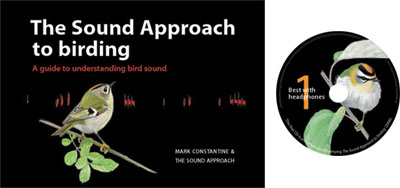The Sound Approach to birding
by Mark Constantine and the Sound Approach
Book and two audio CDs
Published by The Sound Approach
And now for something completely different. The Sound Approach is a book with two accompanying CDs that invites all of us to learn how to be better at identifying bird sounds. 'Yes, please' I hear you say but how many of you will now be put off when I explain that the 'secret' that is proposed in this book is that we should all learn how to use sonograms (those graphs depicting bird sounds as squiggles on a chart). But if you're the sort of person who says they've never understood sonograms, please don't be put off because this book is exactly for you.
It argues that the beauty of sonograms is that it gives a visual picture of bird sound that allows all of us to see what it is we should be listening for to distinguish two sounds. The description of a Willow Warbler call as being 'longer and more disyllabic' than that of a Chiffchaff really does make a lot more sense, and is easier to remember, when you can see what the two calls look like on a sonogram. And when you also compare the calls of Siberian and Iberian Chiffchaffs you can see from the sonograms exactly how different they ought to sound.
So, this book takes on the task of trying to explain to all of us how to read and understand sonograms. This could be incredibly dull but here it is made much more entertaining thanks to two things: an accompanying CD so we can hear the sounds that are illustrated in the sonograms and a terrifically readable text by Mark Constantine. He has the zeal of an evangelist so his descriptions ooze with enthusiasm for his subject. He not only loves bird sounds but he wants everyone to share the excitement he's found through the interpretation of sonograms. I think birders will love the background information he gives about many of the recordings on the disk; who recorded it, where, when, what the place was like, what difficulties had to be overcome etc. We not only read about the birds and their sounds but also about the exploits of people like Magnus Robb, Killian Mullarney and Arnoud van den Berg in their quests to get these recordings.
The book also takes us into new avenues that become possible when we study bird sounds in such detail; like whether we can age Chiffchaffs by their calls or whether there are many species of Crossbills in Europe, all with different calls. Fascinating stuff.
Mark is convinced that if only we could all read sonograms, we'd learn so much more about how to identify bird sounds and give ourselves a whole new vocabulary, beyond 'choo-choo-choo', with which to describe the differences. He hopes this will give us a breakthrough in bird sound identification similar to that brought about by the late Peter Grant when his 'New Approach' led us to be so much more aware of how to identify and describe the different feather-tracts and understand the different moult sequences. He could be right. His argument is certainly convincing and his book definitely achieves its aim of making sonograms more easily understood by all of us.
The book is a terrific read and deserves to be bought by any birders who want to take their sound identification a whole leap further forward. I can't remember the last time I was so impressed, entertained and enlightened by a birding product. Birders everywhere should get this.



